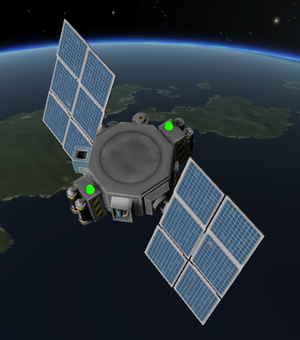Electric charge
Electricity is a resource that is used by unmanned spacecraft, lights, and instrumentation. It is stored using Batteries and is produced through an operating Rocket or Jet Engine, Solar Panels, or an RTG.
Contents
Electricity Consumption
Unmanned Satellite Cores use 1.7 e/m (electricity per minute). Lights and Instrumentation use electricity as well. Also, Ion Engines and rover wheels require large amounts of electricity to operate.
Producing Electricity
Rocket engines
Many rocket engines produce plenty of electricity while running. However, they only do so while they run. Short burns every two minutes can be used to keep a probe alive, but don't forget doing so.
| Engine | Power |
|---|---|
| LV-T30 Liquid Fuel Engine | 1.0/s |
| LV-T45 Liquid Fuel Engine | 1.0/s |
| Rockomax "Poodle" Liquid Engine | 1.0/s |
| Rockomax "Mainsail" Liquid Engine | 2.0/s |
All other rocket engines do not produce electrical energy.
Jet engines
All jet engines produce plenty of electricity while running. However, they only do so while they run and they need an atmosphere with oxygen present like Kerbin or Laythe to operate.
| Engine | Power |
|---|---|
| Basic Jet Engine | 0.8/s |
| TurboJet Engine | 1.0/s |
Solar panels
Solar Panels are a more automatic way to generate electrical energy. They need direct sunlight to work, so they won't work when you are on the night side of a planet you orbit.
All panels except for the OX-STAT Photovoltaic Panels need to be unpacked by right-clicking on them before they will generate energy. Unpacked solar panels are very flimsy and will disintegrate when experiencing atmospheric drag, so keep them retracted during liftoff, aerobraking maneuvers or atmospheric re-entry.
Their energy output depends on their distance and orientation to the sun, but all solar panels except for the OX-STAT Photovoltaic Panels can orient themselves automatically to a certain degree.
They generate more electricity the closer to the Sun they are located. However, they do not currently use the inverse-square law. Rather, they follow a spline curve of 3 piecewise cubics defined from 4 points:
| Distance (m) | Power | Notes |
|---|---|---|
| 0 | 10x | |
| 13,599,840,256 | 1x | Kerbin's orbit |
| 68,773,560,320 | 0.5x | Jool's semi-major axis |
| 206,000,000,000 | 0x | Almost 3x Jool's orbit |
Due to their unreliable nature, it is recommended to have some energy storage as a buffer (see below) when supplying a craft solely with solar panels.
Radioisotope battery
The PB-NUK Radioisotope Thermoelectric Generator is a constant and reliable source of energy which doesn't require direct sunlight and is much more resistant to atmospheric drag than solar arrays. Unfortunately it has a very unpractical shape and generates less energy per kg mass than solar panels under normal conditions. Also, they don't look nearly as cool as solar panels.
Storing energy
A probe command pod can only store 5 units of energy which keeps it alive for not even 3 minutes. To survive longer without energy supply, to deal with peak loads (which often happen when using ion engines) or to bridge time gaps when solar panels aren't usable, batteries can be used to store more energy.
There is the circular Z-500 Rechargable Battery Bank with 500 units of energy designed to be used as a rocket segment and the Z-100 and Z-400 with 100 and 400 units respectively which are designed to be mounted on the outside of a vessel. The Z-100 and Z-400 store twice as much charge per kg of mass, but are less elegant to place.
Manned command pods also store 50 units of energy per crew member maximum capacity. But neither do they consume energy nor do they require any energy to function.
All energy storage available to a craft is fully loaded at launch.
